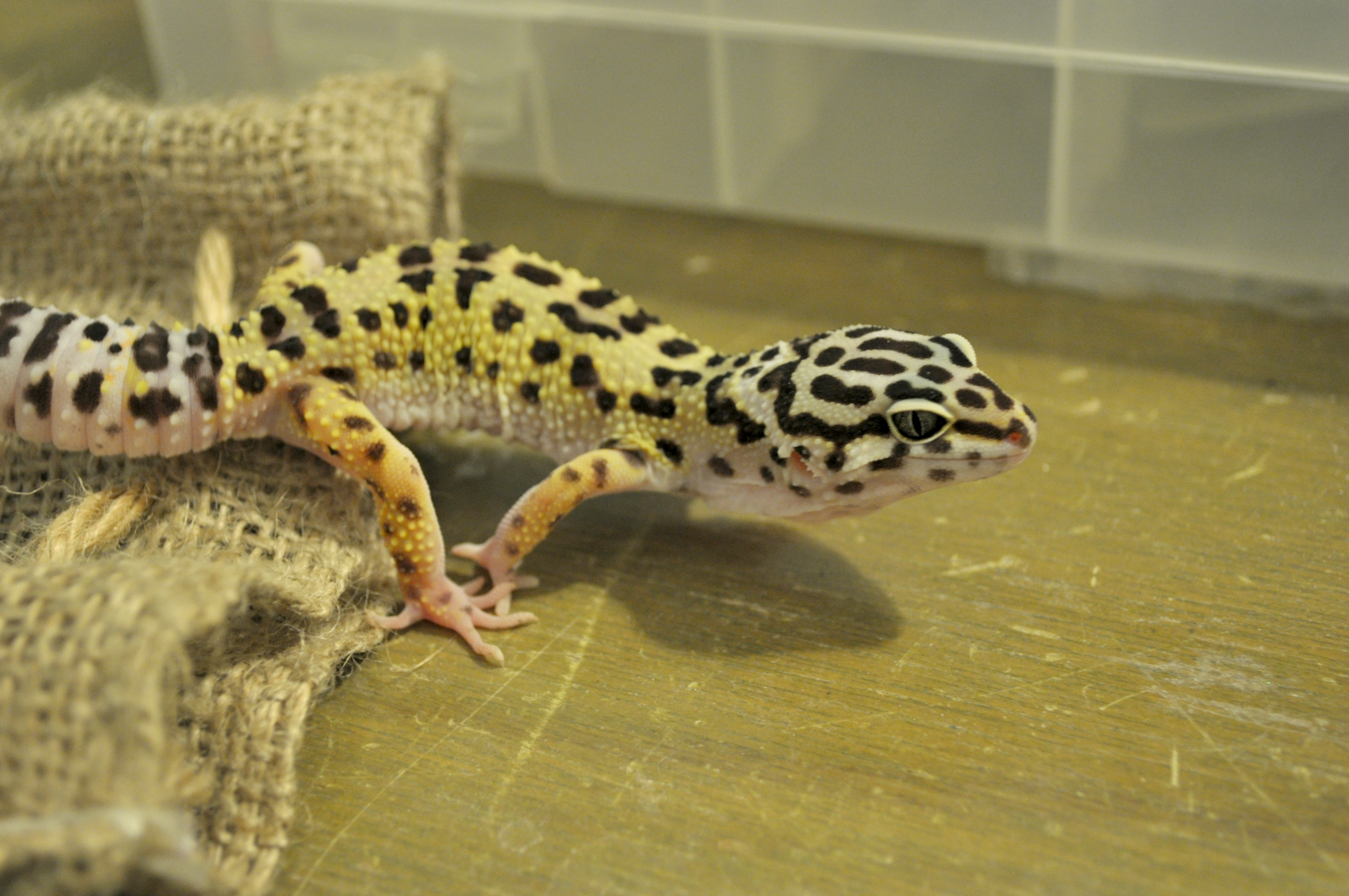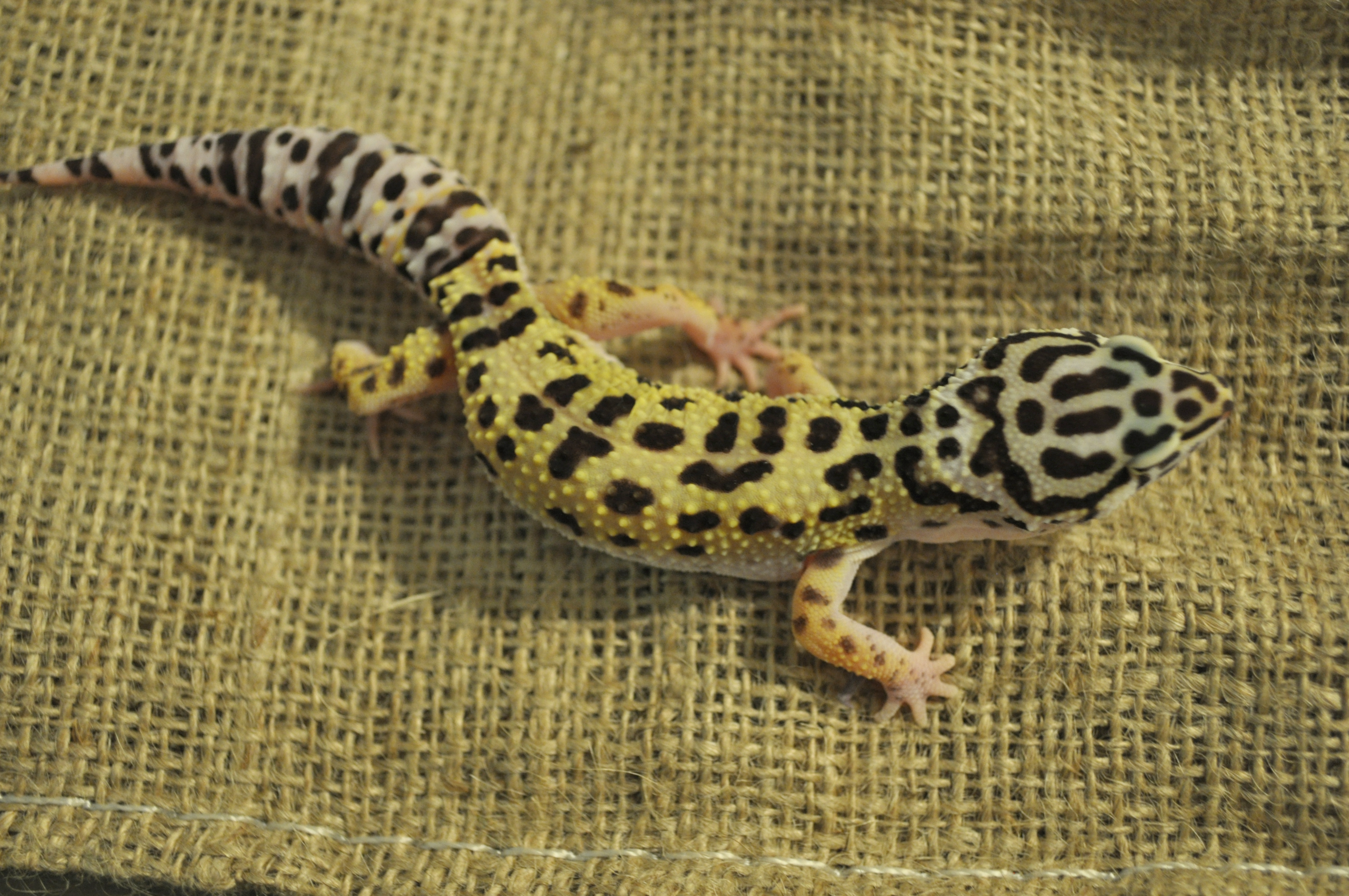General Information
Species of lizard:
Leopard Gecko
Gecko's name:
Banunu
Morph:
High Yellow
Gender:
Male
Age:
~1 year
Weight:
30 grams
Total length:
7 1/2 inches
Length of your reptile when you first acquired it:
~3 inches
Source (pet store, breeder, previous owner):
Petco
Captive bred or wild caught:
Captive Bred
Vivarium
Enclosure dimensions (length x width x heighth):
2' 5.5" x 1' x 1' 6"
Cage (type, size):
Normal 30 gallon
Substrate provided:
Paper Towels
Types of hiding places provided:
a cool hide, it's like a branch that was hallowed out to make a little tunnel, warm hide, it's ceramic and picks up the heat from the ground so it's warm on top, and a moist box a tub that I cut a hole in with moist moss.
Is there a humidity hide? location?
Yes in the center of the tank.
Please describe any other furnishings:
Food dish, 100% pure calcium dish, water dish.
List recent changes in the environment, if any:
New hide and new water dish.
Lighting
Artificial lighting
Incandescent (“screw-in” bulbs):
None
wattage(s):
N/A
Fluorescent (tube bulbs):
None
Natural lighting
Access to ambient daylight from a distant window:
Yes. The tank is under the window. The window's curtain is always shut though, so it just lets a little light seep through.
Heating
Do you have a thermometer(s) in the cage?
Yes
What type and brand of thermometer (digital with probe, temperature gun, LCD strip, analog (circle), combo digital thermometer/hygrometer, stainless steel aquarim type, other):
Caliber III Digital thermometer and hygrometer.
What is the ground temperature right on the substrate under the warm dry hide:
89.8°F
What is the air temperature on the warm end about 6 inches up from the ground:
76.4°F
What is the air temperature on the cool end about 6 inches up from the ground:
73°F
What device(s) are used to maintain the temperature (Under Tank Heater, heat light, ceramic heat emitter, Flexwatt heat tape, hot rock, other):
Under the tank heater.
Are you using a thermostat(s)?
Yes
Which hide does she/he spend most of her time?
That's a tough one. He spends most of his time next to the moist hide... Not in it really
Is the temperature decreased at night? by how much?
I honestly don't know, I doubt by much? The house is kept at 60 degree's at night so the cool end might get that low, but the warm end stays nice and toasty!
Humidity
Is the humidity measured?
Yes
Humidity range:
25%(warm side)-48%(cool side)
Diet
Insects and worms, list type:
Mealworms(I raised them myself), and Superworms produced by Timberline.
Regular diet fed to the insects and worms:
Mealworms get lots of veggies and vitamin powder. I haven't worked things out with the superworms yet since they are still very new to his diet and he won't even eat them.
Are the insects and worms formally “gutloaded” 1-2 days prior to feeding off to your gecko? If so with?
Mealworms are. I give them lettuce, carrots, kale, spinach, cabbage and vitamin powder.
How often do you feed your gecko?
As often as he'll take food. There is usually a constant supply of worms in his food dish since he's underweight.
Please list any supplements (with brand names) used. How are they given and how often?
1. Repashy Superfoods Calcium D3
1.a. Usually twice a week, Tuesday and Thursday, right now things are a little iffy though.
2. Zoo Med Repti Calcium with out D3
2.a. Available at all times in a little cap in the tank.
3. Rep-Cal Herptivite Multivitamins
3.a. I sprinkle a little in his dish so the worms will eat/crawl around in it. Pretty much available at all times
What calcium brand are you using? with D3, without or both?
Both. Repashy Superfoods Calcium with D3, Zoomeds Repti Calcium without D3
Is the calcium in the tank with D3 or without?
Without.
Multivitamins (include brand name)?
Rep-Cal Heptivite with beta carotene Multivitamins
Please list any recent additions/changes in the diet:
Added Superworms to be his staple rather than mealworms. Mealworms are still given though.
General Health
If your gecko is sick, please describe the signs and how long your gecko has been showing these signs:
I don't know for sure... He won't eat and he's started licking his vent more. I'm starting to wonder if him licking his vent just has to do with him reaching sexual maturity? He's been doing it for about a week now.
Is your gecko’s general activity level normal, decreased, or increased?
Is your gecko’s appetite normal, decreased, or increased?
Decreased!!
Have you noticed any of the following?
Weight (loss or gain):
I think gain actually??? Last time I weighed him he was 25 grams, and now he's 30 grams, but he looks like he's lost weight...
Discharge from the eyes or nose:
None of that.
Increased breathing rate or effort:
No.
Change in the droppings:
Not really.
Urates
---white or yellowish:
White I think? It looks a little bit yellow, but that could be the lighting in my room. It's not like bright yellow.
---size of urates as compared to size of feces:
The poop is bigger, and urate is about half the size.
Abnormal skin color or shedding:
Nope.
Parasites on the skin or in the feces:
Not that I can see!
Weakness:
Not that I've noticed. He just climbed his tallest hide with no problems..
Previous problems and/or illnesses:
There's a lot... Okay, so he didn't eat when I first got him. He couldn't catch the crickets we tried to feed him. He wasn't slow, he just missed A LOT and it would get to the point of him giving up. I had to hand feed him most of his life by holding the food to his head until he took it.
Other Critters in Same Cage or in Household
List other animals that are kept in the same cage:
None, he's alone.
Recent acquisitions (new pets within the past 6 months):
None.
Are any of your other pets ill?
Nope.
Okay that's it! Don't think I missed anything..
Oh and, we met before btw, Elizabeth! At the last reptile expo in Wilsonville! And you helped me with fixing Banunu's tank before.

 ) but he doesn't have any runny poop. He poops just fine when I do manage to get him to eat. He's just reluctant to take the food at all??
) but he doesn't have any runny poop. He poops just fine when I do manage to get him to eat. He's just reluctant to take the food at all?? >
>




